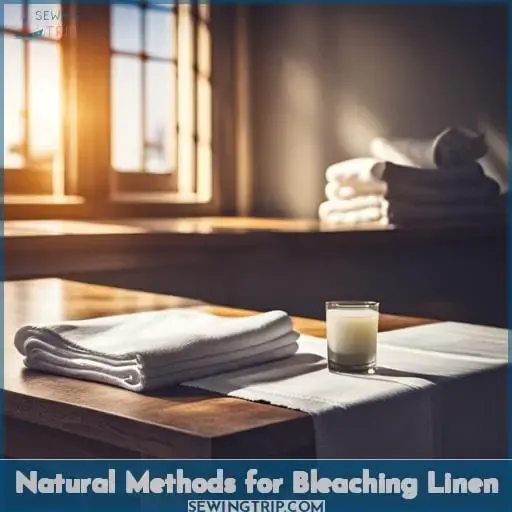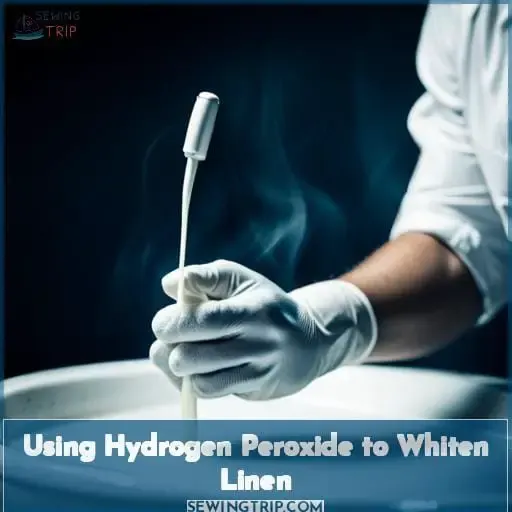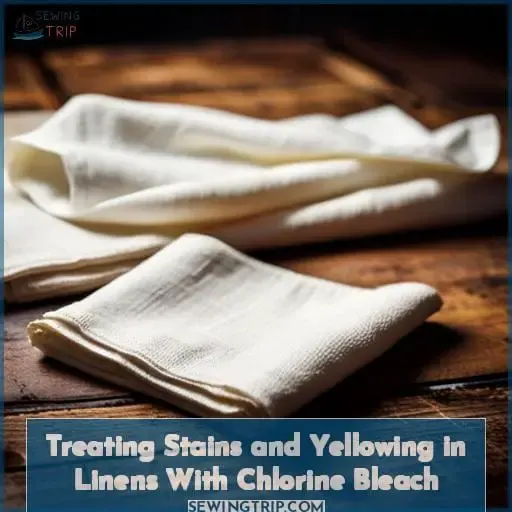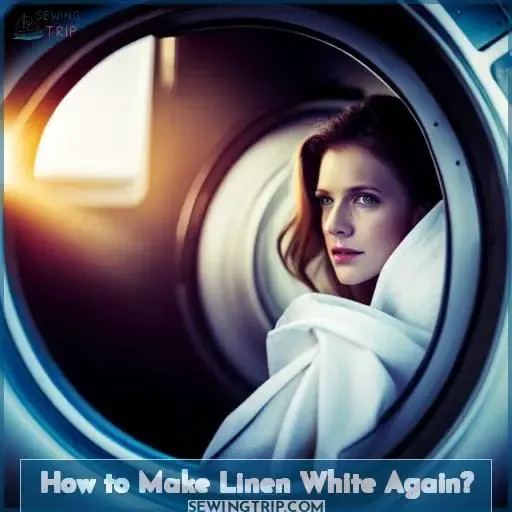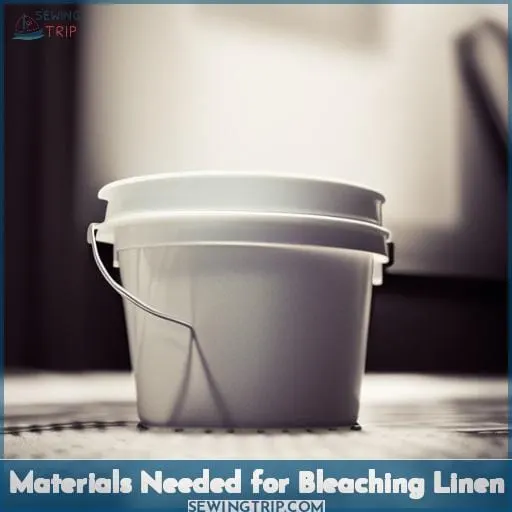This site is supported by our readers. We may earn a commission, at no cost to you, if you purchase through links.
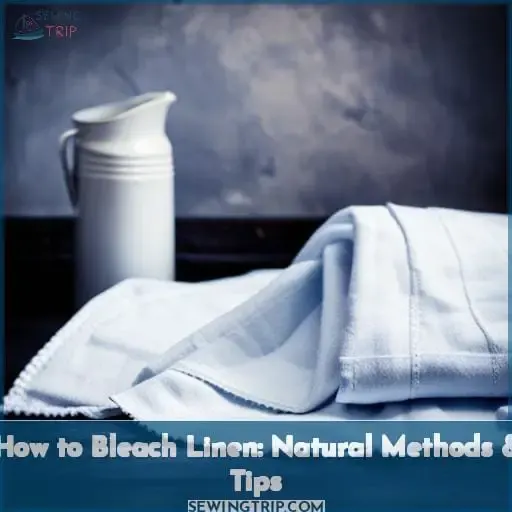 Looking to achieve pristine, white linen? Discover effective ways to bleach your linens using natural methods and expert tips. Say goodbye to stains and yellowing as you restore the brightness of your favorite fabrics.
Looking to achieve pristine, white linen? Discover effective ways to bleach your linens using natural methods and expert tips. Say goodbye to stains and yellowing as you restore the brightness of your favorite fabrics.
From vinegar and baking soda solutions, oxygen bleach, sunlight exposure, lemon juice treatments to hydrogen peroxide for whitening linen – we’ve got you covered! Embrace the power of these techniques that will leave your linens looking fresh and revitalized once again.
Table Of Contents
Key Takeaways
- Vinegar, baking soda, oxygen bleach, sunlight, and lemon juice are natural methods for bleaching linen.
- Hydrogen peroxide can be used to whiten linen.
- Chlorine bleach can be used to treat stains and yellowing in linens.
- Various materials are needed for bleaching linen.
Natural Methods for Bleaching Linen
To naturally bleach linen fabric, you have several options at your disposal.
Try using:
- Vinegar
- Baking soda
- Oxygen bleach
- Sunlight
- Lemon juice
Each method has its own benefits and considerations when it comes to effectively bleaching linen without the use of harsh chemicals.
Vinegar
One effective natural method for bleaching linen is to use vinegar.
To use vinegar, soak the linen in a mixture of 2/3 cup of vinegar and water for 2-3 hours.
Then, add 2/3 cup of vinegar to your washing machine while washing the fabric.
Vinegar helps remove stains and brighten fabrics without causing damage.
You can easily find vinegar at grocery stores or online retailers that sell household cleaning products.
Baking Soda
To bleach linen fabric using baking soda, you can easily create a bleaching solution at home.
- Mix 1 cup of baking soda with 4 liters of water.
- Soak the linen fabric in the solution for a few hours or overnight.
- Pre-treat any stains by creating a paste with ½ cup baking soda, ¼ cup liquid dish soap, and 1 liter of water.
- Boil the linen fabric with another mixture of ½ cup baking soda and ¼ cup salt.
Oxygen Bleach
To continue the discussion on bleaching linen fabric, let’s explore how you can use oxygen bleach as a natural method to whiten your linens.
Oxygen bleach is gentle on fabrics and can be used by adding one cup of it to your washing machine along with your laundry detergent.
Be cautious when handling bleach and consider wearing protective gloves for safety precautions.
Sunlight
Harness the power of sunlight to naturally bleach your linen fabric. Here’s how:
- Choose a sunny location: Find an area outside where your linen can be exposed to direct sunlight.
- Time it right: Leave your linen in the sun for several hours, allowing enough time for the sunlight to work its bleaching magic.
- Check the temperature: Make sure that the temperature is warm enough for effective bleaching.
- Repeat as needed: For stubborn stains or yellowing, you may need to repeat this method multiple times.
Lemon Juice
If you want to naturally bleach your linen fabric, use lemon juice occasionally for a refreshing and effective result.
To use lemon juice on linen, create a mixture of lemon juice and water.
Soak the linen in the mixture for a few hours or overnight.
After soaking, rinse the fabric thoroughly with cold water before washing as usual.
The acidity of the lemon juice helps to break down stains and brighten white linens.
Using Hydrogen Peroxide to Whiten Linen
To whiten linen fabric, you can use hydrogen peroxide as a natural bleaching agent. Hydrogen peroxide is safe to use on linen and can effectively lighten stains and yellowing. You have the power to bleach your linens with hydrogen peroxide, giving them a fresh and bright appearance.
If you want an extra boost of whitening power, you can mix hydrogen peroxide with vinegar for added effectiveness.
However, it’s important to note that while hydrogen peroxide is generally safe for linen fabric, it may cause some damage if used in high concentrations or left on the fabric for too long. Therefore, always test a small area first before treating the entire garment or textile.
Treating Stains and Yellowing in Linens With Chlorine Bleach
Now that you’ve learned about using hydrogen peroxide to whiten linen, let’s move on to treating stubborn stains and yellowing in linens with chlorine bleach. Chlorine bleach is a powerful tool for stain removal, but it should only be used on white linen fabric.
- Determine how much bleach to use: Dilute one cup of chlorine bleach with one liter of water.
- Decide how long to soak the linen: Allow the fabric to soak in the diluted solution for 15 minutes or until desired results are achieved.
- Learn how to rinse properly: After soaking, thoroughly rinse the linen with cold water until all traces of bleach have been removed.
However, it’s important always remember safety precautions when working with chlorine bleach:
- Wear protective gloves while handling chemicals
- Work in a well-ventilated area
- Test a small area before treating the entire garment
In case any damage occurs due to chlorine bleach, you can try to reverse the effects by soaking the fabric in a solution of one tablespoon of white vinegar per gallon of water.
How to Make Linen White Again?
To make linen white again, rinse the linen garments and wash them as usual, then air-dry the garments preferably outside before ironing them while still damp.
Here are some tips to help you achieve that pristine white look without using bleach:
- Test fabric first: Before treating your entire linen garment, test a small area to ensure it doesn’t get damaged during the process.
- Rinse thoroughly: After washing your linen garments, make sure to rinse them thoroughly with cold water to remove any residual detergent or cleaning agents.
- Air dry: Instead of using a dryer, air-dry your bleached linen items outside if possible. The fresh breeze will help in removing any remaining stains or discoloration.
- Iron damp: Once your linens are almost dry but still slightly damp, iron them on low heat. This won’t only remove wrinkles but also enhance their whiteness.
By following these steps and avoiding bleach altogether when whitening linens like napkins or clothing items made from this versatile fabric can be effectively restored back into their original color without compromising quality.
Materials Needed for Bleaching Linen
You will need a few materials to successfully bleach linen fabric.
To ensure safety, it’s important to have gloves on hand before starting the process.
Additionally, you’ll need a bucket or container large enough to hold the linen and water for soaking.
The water itself plays a crucial role in diluting any bleaching agents used during DIY bleaching methods.
Lastly, gather your linen fabric that you wish to bleach and make sure it’s clean before proceeding with any of the natural methods mentioned earlier in this article.
Frequently Asked Questions (FAQs)
Can I use bleach alternatives to whiten linen fabric?
Yes, you can use bleach alternatives like vinegar, hydrogen peroxide, oxygen bleach, and lemon juice to whiten linen fabric.
Follow the instructions carefully and test a small area first to ensure desired results without damaging the material.
How long should I let the hydrogen peroxide mixture sit on the fabric?
Let the hydrogen peroxide mixture sit on the fabric for 30 minutes. This will give it enough time to work its magic and effectively whiten your linen.
Can I use oxygen bleach on colored linen fabric?
Yes, you can use oxygen bleach on colored linen fabric. It’s a gentle non-chlorine bleach that won’t damage the fabric.
Follow the instructions on the package and run your wash on a hot water cycle for effective results.
What should I do if the chlorine bleach test damages the fabric?
If the chlorine bleach test damages your linen fabric, try using a natural method or oxygen bleach instead.
Soak the fabric in vinegar, sunlight, baking soda solution, or hydrogen peroxide to restore its color without causing further damage.
Can I bleach linen in a top load washing machine?
Yes, you can bleach linen in a top load washing machine.
Follow the instructions for your chosen bleaching method and ensure proper ventilation.
Feel the power as you transform your fabric from dull to vibrant white.
Conclusion
To achieve pristine, white linen, embrace the power of natural methods and expert tips for bleaching.
Vinegar, baking soda, oxygen bleach, sunlight exposure, lemon juice, and hydrogen peroxide are all effective options for restoring the brightness of your linens.
Additionally, chlorine bleach can be used for treating tough stains and yellowing.
With these techniques and the right materials, you can make your linen white again.

